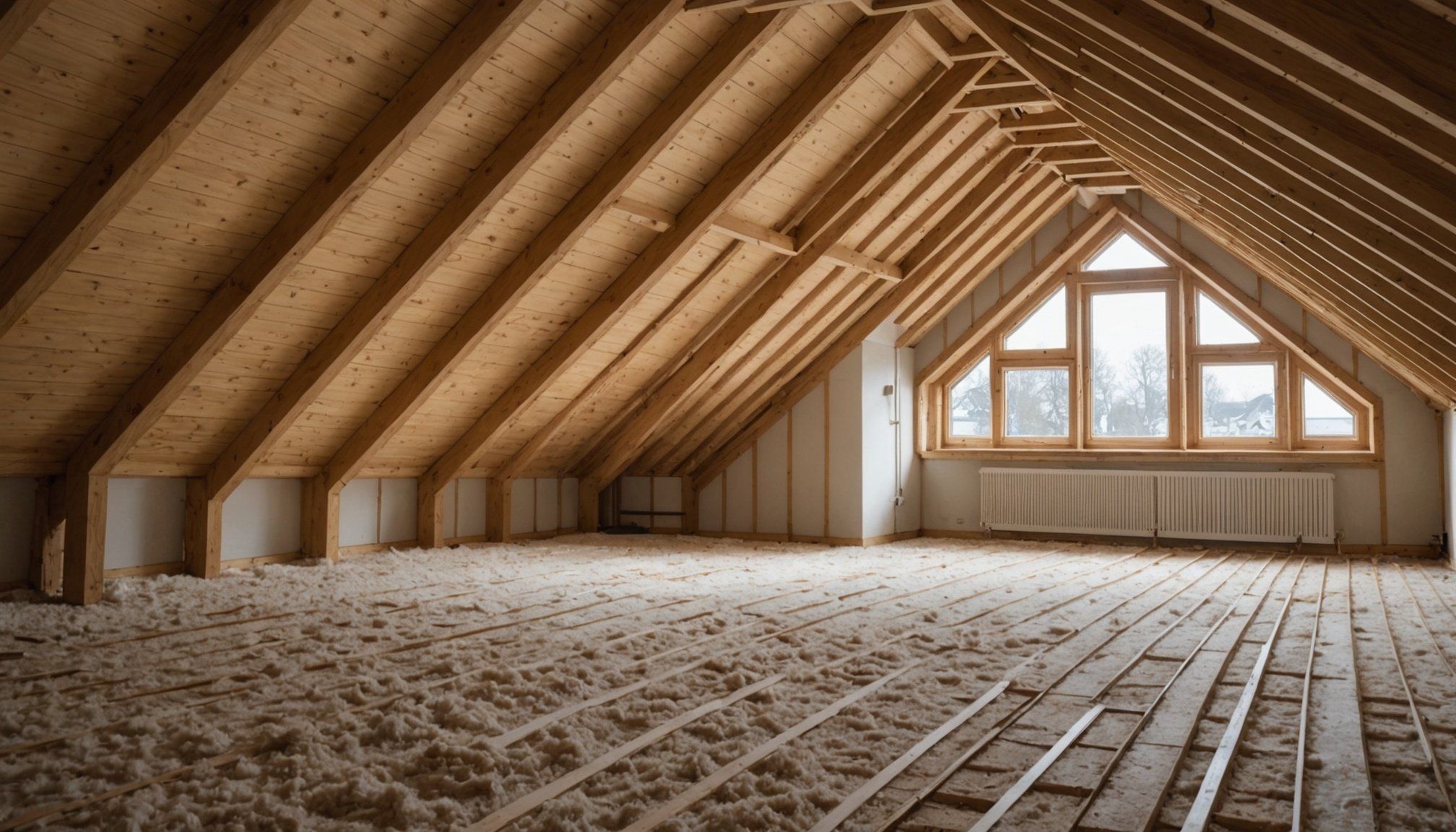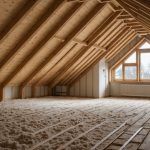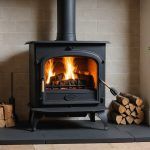Overview of Insulation Solutions for UK Attics
When it comes to insulation solutions for UK attics, their primary function is to combat winter heat loss. Proper attic insulation is crucial in maintaining a consistent indoor temperature, thereby reducing heat loss which is prevalent in colder months.
Common Insulation Materials
The typical materials used in UK attics include fiberglass, mineral wool, and spray foam. Each material boasts its own thermal performance, making it vital for homeowners to understand their unique properties and benefits. Fiberglass is a popular choice due to its cost-effectiveness and ease of installation, while mineral wool offers enhanced fire resistance and soundproofing. Spray foam provides excellent air sealing capabilities, though typically at a higher cost.
Also to see : Ultimate guide to maintaining your wood-burning stove in a uk home: expert tips and best practices uncovered!
Impact on Energy Efficiency and Costs
Effective insulation significantly enhances a home’s energy efficiency, which is reflected in reduced energy bills. By minimizing heat escape, homeowners can expect considerable savings over time. Thus, investing in high-quality insulation solutions not only addresses winter heat loss but also contributes to overall financial savings and improved living conditions. Additionally, the increased property comfort may boost market value, making insulation an investment with multiple returns.
Types of Insulation Materials
Understanding the types of insulation materials available for UK attics is essential for homeowners looking to enhance their home’s thermal performance. Each material offers distinctive benefits tailored to specific needs.
Also read : Ultimate guide to installing a home elevator in your uk townhouse: proven tips and best practices revealed
Fiberglass Insulation
Fiberglass is a prevalent choice due to its affordability and ease of installation. It’s made from fine glass fibers, providing effective thermal insulation. Pros include cost-effectiveness and fire resistance, while cons involve potential skin irritation during installation and lower insulation performance in extremely cold conditions. Installation generally involves laying batts or using blown-in techniques, making it a suitable DIY project if handled with care.
Mineral Wool Insulation
This material offers superior fire resistance and soundproofing, ideal for environments where these factors are crucial. In winter conditions, mineral wool maintains its thermal integrity better than some other materials. However, its environmental impact is worth considering, as production can involve high energy consumption, although it is often made from recycled materials.
Spray Foam Insulation
Renowned for its insulating efficiency and air sealing capabilities, spray foam can create a seamless thermal barrier in attics. Despite the higher upfront costs, long-term savings from enhanced energy efficiency can be significant. Professional installation is recommended due to the complexity of application and health safety considerations.
Installation Techniques
When approaching insulation installation, choosing between DIY techniques and hiring professionals is crucial. DIY insulation can be a cost-effective option if the right safety measures and equipment are used. Essential tools include protective clothing, masks, and goggles, especially when handling materials like fiberglass that could cause irritation. Use careful measurements, ensuring the material fits snugly to avoid gaps that may lead to heat loss.
For large or complex projects, professional installation is often advisable. Experts ensure optimal thermal performance and safety compliance, using advanced techniques and tools that are often inaccessible to DIY enthusiasts. They can also navigate challenging areas, such as tight corners or uneven surfaces, where insulation could be difficult to install correctly.
It’s important to assess project complexity and your own skill level to decide whether a DIY approach or professional assistance is best. When hiring a professional, verify their credentials and experience. This ensures the insulation solution adheres to UK safety standards, maximising energy efficiency benefits. Regardless of the choice, proper installation is key to minimising winter heat loss and enhancing the overall efficiency of UK attics.
Cost Considerations
When considering insulation costs for UK attics, understanding the financial implications is crucial for budgeting. Different insulation materials come with varying price tags. For example, fiberglass insulation is generally the more affordable option compared to mineral wool and spray foam. Mineral wool typically costs more due to its additional benefits like fire resistance and soundproofing qualities. Spray foam, despite its higher initial expense, can offer substantial long-term savings through superior energy efficiency.
Long-term savings from energy efficiency are a significant advantage of investing in quality insulation. By reducing winter heat loss, homeowners can expect noticeable decreases in heating bills, balancing out the upfront costs over time.
Additionally, homeowners should explore the availability of grants and funding for insulation projects, which can alleviate some financial burdens. Various government programmes and energy companies offer financial incentives to encourage sustainable energy use, making these potential options worth investigating.
Careful budgeting and considering these potential savings are essential steps in making a well-informed decision about insulation solutions for attics, thus ensuring both immediate and long-term economic benefits.
Benefits of Quality Insulation
Investing in quality insulation solutions for your UK attic can yield significant advantages, particularly during the colder months when addressing winter heat loss is crucial. By maintaining a stable indoor temperature, effective insulation not only reduces reliance on heating systems but also leads to substantial energy conservation. This improved energy efficiency is reflected in reduced heating bills, providing homeowners with noticeable financial relief throughout the winter season.
Beyond cost savings, superior insulation enhances overall home comfort. A well-insulated attic minimizes temperature fluctuations, enabling a more consistent and comfortable living environment. Consequently, this stability translates into a more pleasant atmosphere for occupants, reducing the need to constantly adjust thermostats or use additional heating solutions.
Additionally, high-quality insulation can potentially increase property value. Prospective buyers often regard energy-efficient homes as more desirable, recognizing the long-term savings and comfort associated with effective insulation. As a result, investing in top-tier insulation not only benefits current homeowners but also contributes positively to a home’s market appeal.
In summary, the multiple advantages of quality insulation are evident—not only through immediate financial savings and enhanced comfort but also in the potential boost in property value.
Government Regulations and Building Standards
In the UK, building regulations play a crucial role in guiding attic insulation practices. These regulations ensure that insulation solutions adhere to specific safety and performance standards, ultimately enhancing energy efficiency and safety in homes. Compliance not only supports winter heat loss mitigation but also guarantees that insulation materials are safely installed.
Adhering to UK standards is essential to ascertain that insulation is both safe and effective. Key regulations focus on thermal performance, fire safety, and moisture control, ensuring homeowners select appropriate materials and techniques. Non-compliance may lead to potential safety hazards and invalidated insurance policies, making it imperative for homeowners to stay informed.
Understanding local regulations may seem daunting, but various resources are available to help. Government websites offer detailed guides on current insulation compliance requirements, and professional contractors often provide insights into how these standards apply to specific attic conditions. For those planning a DIY project, consulting these resources prior can help prepare for a successful installation.
To optimise both safety and effectiveness, it’s advisable to regularly check for updates in building standards, which may vary across regions, thereby assuring the longevity and reliability of the insulation.
Practical Tips for Effective Insulation
Embracing effective insulation practices in your UK attic can profoundly enhance your home’s thermal performance and energy savings. Regular inspections and maintenance play a crucial role in ensuring your insulation solutions remain efficient. Over time, insulation can settle or become damaged, leading to increased winter heat loss. Routine checks can help identify and rectify these issues promptly, maintaining optimal performance.
Improving attic ventilation is another essential tip, as it aids in preventing moisture build-up, which might compromise insulation effectiveness. Proper ventilation prevents condensation, a common issue that could lead to mould growth and degrade insulation materials.
Avoiding common mistakes is key during insulation projects. This includes ensuring a snug fit for insulation materials without leaving gaps, which are potential heat-loss culprits. Common errors often stem from incorrect measurements or neglecting to address hard-to-reach corners.
Implementing these tips not only boosts the longevity of your insulation but also fortifies your home against winter heat loss, maximising energy efficiency. Addressing these practical aspects provides homeowners with a reliable framework to maintain insulation solutions, ultimately enhancing comfort and reducing costs during frigid months.
Case Studies and Real-life Examples
Real-life examples of successful attic insulation projects in the UK highlight the significant benefits of selecting appropriate insulation solutions. These case studies often showcase dramatic improvements in energy efficiency, particularly concerning winter heat loss, as homeowners adopt strategies tailored to their specific attic conditions.
One notable case study involved a Victorian terrace house, where replacing outdated materials with modern fiberglass insulation led to energy savings of up to 25% annually. Such home projects underline the efficacy of insulation materials in improving thermal performance and reducing household heating requirements.
In another example, a rural bungalow utilised spray foam insulation to address moisture issues in its attic. This approach not only enhanced the seal against external elements but also contributed to a 40% reduction in heating costs, demonstrating the long-term financial benefits that can correlate with these improvements.
User testimonials often reflect satisfaction with enhanced comfort, noting fewer temperature fluctuations and improved air quality. These insights underline the value of a custom-fit insulation plan, considering individual home requirements and climate variances across the UK.
Exploring these real-world stories can guide homeowners in selecting the most suitable insulation solutions for their unique situations.
Comparison of Insulation Solutions
Choosing the right insulation solutions for UK attics requires careful consideration of each option’s cost and thermal performance. Homeowners often weigh fiberglass, mineral wool, and spray foam against factors like effectiveness and budget to make the best decision.
Fiberglass remains a popular choice due to its affordability and decent thermal performance. It suits those seeking a balance between cost efficiency and moderate insulation capabilities. However, for attics in extreme climates, it might not offer sufficient warmth retention.
Mineral wool, known for its superior fire-resistant properties, tends to cost more but excels in environments where these features are critical. It maintains thermal performance better in colder winter conditions, making it a strong candidate for stations with brisker temperatures.
Spray foam stands out for its excellent airtight sealing and insulation prowess, despite higher initial expenses. Its ability to reduce winter heat loss considerably makes it a compelling long-term investment where energy savings are prioritised.
Ultimately, the decision involves aligning insulation solutions with attic specifics, weighing cost against performance benefits, and considering UK standards to ensure compliance and optimal energy efficiency.











